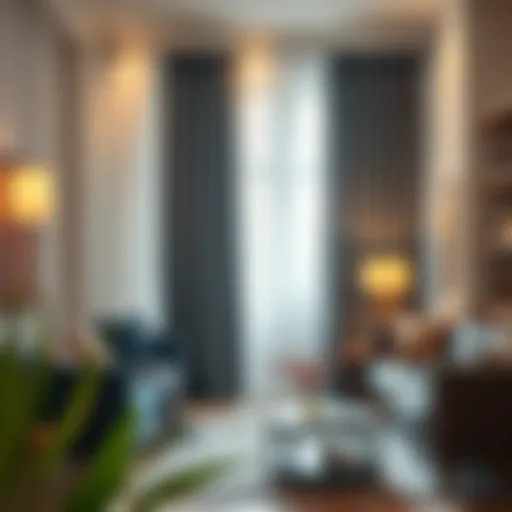Upholstered Toy Boxes: Style Meets Practicality

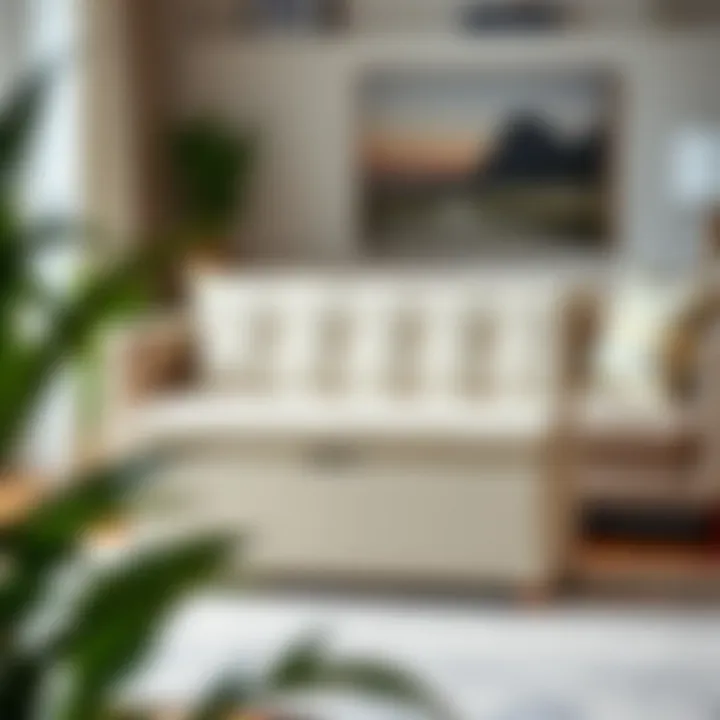
Intro
Upholstered toy boxes are more than just storage solutions; they render elegance and multifunctionality that fit snugly into the narrative of modern interiors. In homes where aesthetics meet practicality, these decorative pieces offer a tidy way to store toys and maintain a clean space. The allure of upholstered toy boxes lies not only in their functionality but also in their design flexibility. As the lines between style and storage blur, understanding key factors like material selection, construction methods, and maintenance becomes essential for homeowners and designers alike. This article dives into various aspects of upholstered toy boxes, illuminating how they can transform a chaotic play area into an organized, stylish nook.
Design Inspiration
Trending Furniture Styles
When it comes to choosing an upholstered toy box, one’s design preferences play a significant role. Current furniture styles have shifted toward more organic shapes and textures, adding a sense of warmth to spaces. A notable trend is the Scandinavian minimalist vibe, where simple lines and functionality take the forefront. Picture a sleek, upholstered box adorned with muted colors—such as soft greys or pastel blues—nestled in a warm wooden room.
Another trend is the revival of mid-century modern designs, characterized by bold patterns and geometric forms. An upholstered toy box in vibrant mustard yellow could serve as a striking focal point against the backdrop of neutral walls.
Furthermore, the eclectic bohemian style embraces bright colors and mixed materials. Here, a toy box with intricate patterns and a variety of textiles can easily become a conversation starter.
Color Palettes and Combinations
Choosing the right color palette can elevate the overall ambiance of a space. Integrating your upholstered toy box with existing decor is crucial. Soft, muted tones often create a calming atmosphere, making them ideal for nurseries or playrooms. Consider palette combinations like beige paired with light pink or sage green combined with taupe.
On the other hand, if you prefer a lively environment, go for brighter hues. Think vibrant turquoise with cheerful mustard accents or striking red contrasted against crisp white. These combinations can turn an ordinary room into an inspiring play area.
Practical Advice
Furniture Maintenance Tips
Maintaining an upholstered toy box is simpler than one might think, yet important to ensure longevity. Regularly vacuuming the surface can prevent dust and dirt build-up. Spills, which are bound to happen in households with children, should be addressed immediately. Use a gentle, damp cloth to blot any stains, avoiding harsh chemicals that might degrade the fabric.
For deeper cleaning, consider using fabric-safe upholstery cleaners. Always check the care tags for specific instructions. In case of wear and tear, some manufacturers offer repair or reupholstery services, extending the life of the piece significantly.
Space Planning Solutions
Placement of an upholstered toy box can impact not just aesthetics, but functionality. Positioning it near play areas or common spaces makes it easily accessible for littles ones, encouraging tidiness. However, it's also essential to ensure the box doesn’t obstruct pathways. A clever trick is to use it as additional seating; vibrant and cushioned, it can double as a lovely bench in a child's room or living area.
Moreover, if space is tight, look for multifunctional options, such as those that include built-in storage compartments or even seating capabilities. These space-saving solutions are ideal for maximizing utility while keeping your decor stylish.
By drawing inspiration from designs, colors, and practical uses, selecting the right upholstered toy box becomes an informed decision, marrying aesthetics with functionality.
Prelude to Upholstered Toy Boxes
Upholstered toy boxes have carved out a distinct niche in home decor that combines functionality with aesthetic appeal. These items are not just storage solutions; they embody a blend of craftsmanship, design, and practicality that appeals to homeowners, designers, and decorators alike. As spaces become more compact and the need for organized storage grows, the relevance of upholstered toy boxes continues to expand. Not only do they keep toys neat and orderly, but they also serve as decorative elements that can enhance the overall look of a room, turning clutter into a stylish focal point.
Defining Upholstered Toy Boxes
When we talk about upholstered toy boxes, we refer to boxes cushioned with fabric that are commonly used for storing children's toys. They come in a variety of shapes, sizes, and styles. The essence of an upholstered toy box lies in its dual function—serving as a storage chest while also providing a soft, comfortable surface that can double as seating. Typically, these boxes are constructed with sturdy frames covered in foam padding and a selection of fabrics that can range from cozy cotton to luxe velvet. The versatility in design allows them to fit seamlessly into different rooms, from a child’s bedroom to a family room, making them an essential piece of versatile furniture.
Historical Context and Evolution
The concept of the toy box traces back to ancient times when children’s belongings were kept in simple chests. However, the upholstered toy box as we recognize it today began to emerge in the late 19th to early 20th centuries. At that time, advances in padding and upholstery allowed manufacturers to create softer, more inviting storage solutions. The evolution continued across decades, with designs reflecting prevailing trends in home décor—art deco influences gave way to the mid-century modern shapes, and then into the vibrant colors and patterns of the 1980s and 1990s. Today, these toy boxes not only serve practical purposes but also reflect individual styles, utilizing sustainable materials and innovative designs.
"In a world that often values minimalism, an upholstered toy box offers a splash of color and warmth, showcasing a personality that is as multifaceted as its owner."
Thus, upholstered toy boxes have transitioned from simple storage solutions to sophisticated elements of home design, serving both functional and aesthetic purposes. This evolution is crucial to understand as we explore how these items can be integrated into contemporary spaces.
Design Elements of Upholstered Toy Boxes
Understanding the design elements of upholstered toy boxes is crucial for several reasons. First, the appeal of these pieces lies in their ability to seamlessly marry aesthetics with functionality. To create a toy box that is both beautiful and practical, one needs to consider shapes, sizes, colors, and various materials. Each of these aspects plays a significant role in how the toy box will fit into the home environment, serve its purpose, and withstand daily use.
Shapes and Sizes
Upholstered toy boxes come in a myriad of shapes and sizes, each offering unique advantages. The classic rectangular shape may be the most common, but round and even irregular shapes can add flair to a room. Round toy boxes can be particularly useful in small spaces, allowing for easier movement without sharp edges causing a fuss. Different sizes cater to various needs; smaller boxes work well in compact areas while larger ones can double as a seat or footrest.
Color and Fabric Choices

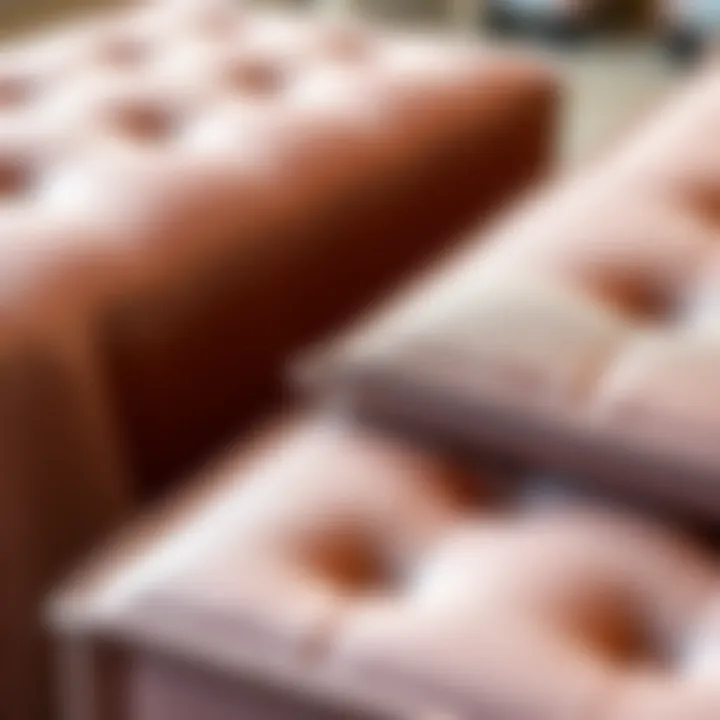
Popular Fabric Types
When it comes to fabric choices for upholstered toy boxes, materials like cotton, linen, and faux leather stand out. Cotton is often regarded as a favorable option due to its breathability and easy maintenance. The soft texture makes it comfortable for children to sit on or lean against. Linen, while chic, can be a bit trickier since it wrinkles more easily, but its natural look can bring warmth to a space. On the other hand, faux leather brings in a modern touch and is easier to clean, although it might get warmer when in direct sun.
- Considerations:
- Cotton: Comfortable, breathable but may wear out over time.
- Linen: Stylish but requires delicate handling.
- Faux Leather: Modern look with easy upkeep but can get warm.
Color Theory in Toy Box Design
The significance of color theory cannot be underestimated. From stimulating creativity to crafting a soothing environment, color impacts more than just design; it affects mood and energy within a space. Bright colors like yellow or red can energize a child's play area while softer shades such as pastel blues or greens can create a calm atmosphere conducive to relaxation.
- Benefits:
- Bright colors: Stimulate creativity and playfulness.
- Soft tones: Promote tranquility and comfort.
Detailing and Customization Options
Embroidery and Patterns
The detailing on upholstered toy boxes elevates them from mere storage solutions to design statement pieces. Embroidery can add an element of uniqueness that reflects the personality of the child or the room's decor. For example, a child’s name or a favorite animal embroidered onto the box not only makes it personal but also ensures it stands out. Patterns such as polka dots or stripes can enhance visual interest and make the toy box align with other decor elements in the space.
Personalized Features
Customization doesn’t stop at fabric and color; specific personalized features can transform an ordinary toy box into a cherished heirloom. From monograms to custom images, these touches resonate deeply with those who use them. Personalization offers emotional significance, making playtime more special for children. However, it is worth mentioning that excessively customized designs may limit the box's versatility as a decor element in a room that evolves over time.
Choosing the right design elements for an upholstered toy box entails looking beyond surface appearances. Instead, it invites an exploration into how various shapes, colors, and personalization options work in concert to create not just storage solutions, but focal points in a child’s space that can grow alongside them.
Functionality of Upholstered Toy Boxes
Upholstered toy boxes are not simply decorative accents in a room; they serve multiple functional purposes that cater to the needs of modern households. Their importance lies in their ability to merge aesthetic appeal with utility, providing solutions to everyday storage challenges while adding charm to any space. This section delves into the diverse functionalities of these versatile pieces, focusing on their organizational benefits and their dual role in home design.
Storage Solutions and Organizational Benefits
One of the standout features of upholstered toy boxes is their capacity to tackle clutter effectively. Unlike rigid storage options, these soft-lined containers are designed to accommodate a variety of toys and items, making them ideal for not just nurseries but also for family rooms and play areas.
- Flexible Capacity: Due to their structure, upholstered toy boxes can store anything from plush toys to books, offering a flexible solution that can adapt to a family's changing storage needs.
- Visibility and Accessibility: Unlike the hidden storage in drawers, an upholstered toy box allows children to see their items, encouraging them to engage with their toys. This visibility also aids caregivers in quickly locating specific toys without endless searching.
- Organizational Techniques: Adding small bins or organizers within the toy box can further optimize space usage. Parents can divide toys by type or size, thus teaching kids valuable organization skills while maintaining aesthetic harmony.
"Tackling clutter with style - that’s the magic of upholstered toy boxes!"
This ability to provide ample storage while encouraging a neat environment contributes significantly to overall household harmony, especially in spaces where children are frequently playing.
Dual Purpose: Seating and Storage
In today's design landscape, maximizing functionality is crucial. Upholstered toy boxes provide a seamless blend of seating and storage, making them incredibly popular in homes.
- Versatile Furniture: They can be placed in a child’s room, playroom, or even the living room, where they serve as both a seat and a savvy storage solution. When extra seating is needed, these toy boxes can do the trick without taking up additional space.
- Encouraging Interaction: Kids can use them as a small bench for reading or playing, promoting a sense of involvement and creativity. This interactive aspect makes them more than just a place to keep toys, transforming them into spaces of imagination.
- Stylish Seating Options: Many upholstered toy boxes come with soft cushions or padded tops, making them not only practical but also a stylish addition to any décor. Parents don’t have to compromise style for functionality or vice versa.
In summary, the duality of upholstered toy boxes as both seating and storage makes them an indispensable element in thoughtful home design. Their multifunctionality aligns well with contemporary living, where space often comes at a premium.
Material Considerations
When selecting an upholstered toy box, material considerations play a pivotal role in ensuring the piece not only aligns with aesthetic preferences but also meets functional demands. The interplay of fabric choices, structural integrity, and craftsmanship greatly impacts the longevity and usability of the toy box. As these elements form the foundation of the product, understanding them enhances the decision-making process for homeowners, designers, and decorators alike.
Types of Upholstery Materials
Natural vs. Synthetic Fabrics
Natural fabrics bring a sense of timeless elegance and warmth. Materials like cotton, linen, and wool offer breathability and softness, making them cozy for use in children's spaces. However, they may not always stand the test of spills and stains as allies. On the flip side, synthetic fabrics, such as polyester and nylon, provide a tougher exterior, often treated to resist wear, fading, and moisture.
- Natural fabrics:
- Synthetic fabrics:
- Pros: Breathable, eco-friendly, hypoallergenic.
- Cons: Can be susceptible to stains and may require more care.


- Pros: Durable, low maintenance, stain-resistant.
- Cons: May not provide the same warmth and comfort of natural options.
Ultimately, the choice between these materials can depend on lifestyle; for instance, families with younger children may favor synthetic fabrics for their resilience, whereas a more design-focused space may benefit from the aesthetic appeal of natural fabrics.
Durability Considerations
Durability is paramount in choosing the right upholstery for a toy box. High-quality materials can withstand the rigors of daily use, particularly in households busy with children’s activities. Upholstered toy boxes face frequent handling, so materials that endure wear and tear while maintaining their look are crucial.
- Key Characteristics:
- Resistance to fading and staining.
- Ability to maintain structural integrity over time.
Durability can often lead homeowners to prioritize synthetic fabrics, which tend to resist damage from play. However, investing in high-quality natural materials can also pay off by offering a sophisticated aesthetic coupled with adequate maintenance strategies to keep them looking pristine, albeit with a bit more effort in care.
Structural Materials and Construction
Frame Materials
The robustness of an upholstered toy box starts with its framework. A solid frame is essential for ensuring longevity. Common materials include particleboard, plywood, and hardwoods.
- Particleboard is lightweight and cost-effective but can be less durable.
- Plywood offers a balance between weight and strength.
- Hardwoods, such as oak or maple, provide excellent longevity and can withstand considerable use.
Each of these choices brings unique benefits and challenges. For families prioritizing long-term reliability, solid wood may be the superior option, while those on a budget may find particleboard to suffice if complemented with sturdy design features.
Quality of Craftsmanship
Quality craftsmanship is the unsung hero of furniture longevity. Attention to detail in construction affects the durability and aesthetics of upholstered toy boxes. This encompasses everything from how tightly the upholstery is secured to the precision of joints and finishes.
- Key Characteristics:
- Precision in stitching and upholstery application.
- Strong bonding and joining methods employed in assembly.
Handcrafted pieces often showcase superior craftsmanship, lending an element of uniqueness and character. While they may come at a steeper price, the investment reflects in the durability and timeless design.
Maintenance and Care
Maintaining upholstered toy boxes is crucial for ensuring their longevity and functionality. Regular care not only preserves their visual appeal but also contributes to a healthier home environment, particularly in houses with children. The cost of replacing a worn-out toy box can often be higher than the cost of regular maintenance. With that in mind, understanding the best practices for cleaning and repairing these versatile storage solutions is essential for every homeowner, designer, and decorator.
Cleaning Upholstered Fabrics
Cleaning upholstered fabrics might seem daunting, but it doesn't have to be. Regular cleaning helps to remove dust, allergens, and stains, maintaining a fresh appearance. Here are some practical steps to consider:
- Vacuum Regularly: Using a vacuum with an upholstery attachment can help remove dust and loose dirt. This should be done at least once a month, depending on the usage and location of the toy box.
- Spot Clean Stains: For spills, it’s important to act quickly. Blot the area gently with a clean, dry cloth to absorb as much liquid as possible. Avoid rubbing, as this can spread the stain. A mild soap solution can be used if necessary, but always test it on a hidden area first.
- Professional Cleaning: Depending on the fabric, you might want to invest in professional cleaning services every few years. This service can deep clean the upholstery without damaging it.
- Follow Care Instructions: Different fabrics have specific care instructions. Always check the manufacturer’s label before opting for any cleaning method.
"Just like a good book, the story of a toy box remains polished when you take care of it."
Repairing Common Wear and Tear
Even with the best of care, wear and tear can occur. Knowing how to address those issues promptly can extend the life of your upholstered toy box. Some common problems and their solutions include:
- Loose Seams: If you notice seams starting to come apart, use a needle and thread to stitch them back together. For more complicated repairs, consider consulting a professional.
- Dents and Cracks: If the structure starts to show dents, especially in wooden frames, carefully applying heat can often help. A steam cleaner—if used carefully—can help rejuvenate the affected areas without compromising the integrity of the fabric.
- Discoloration: Over time, some fabrics may fade. In this case, consider reupholstering with a color that complements your home’s decor. This not only refreshes the look but also contributes to the overall aesthetic of the room.
- Foam Replacement: If the padding inside your toy box is sagging, it might be time to replace it. Having good quality foam can enhance comfort and maintain shape while prolonging the life of the upholstery.
By taking these steps in maintaining and caring for upholstered toy boxes, one ensures that these pieces remain attractive and functional throughout the years. Making maintenance a regular part of your routine will save you time and hassle in the long run.
Current Trends in Upholstered Toy Boxes
Keeping up with the latest trends in upholstered toy boxes is essential for homeowners and designers alike. These pieces of furniture go beyond mere functionality; they are pivotal in making a home feel cohesive and stylish. A toy box today isn’t just a storage solution but a design statement. Understanding the current trends helps one make informed choices, ensuring that the toy box aligns with both aesthetic preferences and practicality.
Sustainable Materials and Eco-Friendly Designs
Sustainability has taken center stage in home decor, and upholstered toy boxes are no exception. The growing awareness about environmental issues has led many manufacturers to innovate with materials that are eco-friendly. Consumers today gravitate towards options like organic cotton, recycled polyester, and reclaimed wood, which not only reduce environmental impact but also enhance indoor air quality.
- Benefits of Sustainable Materials:
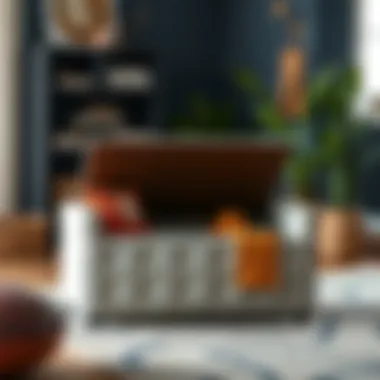
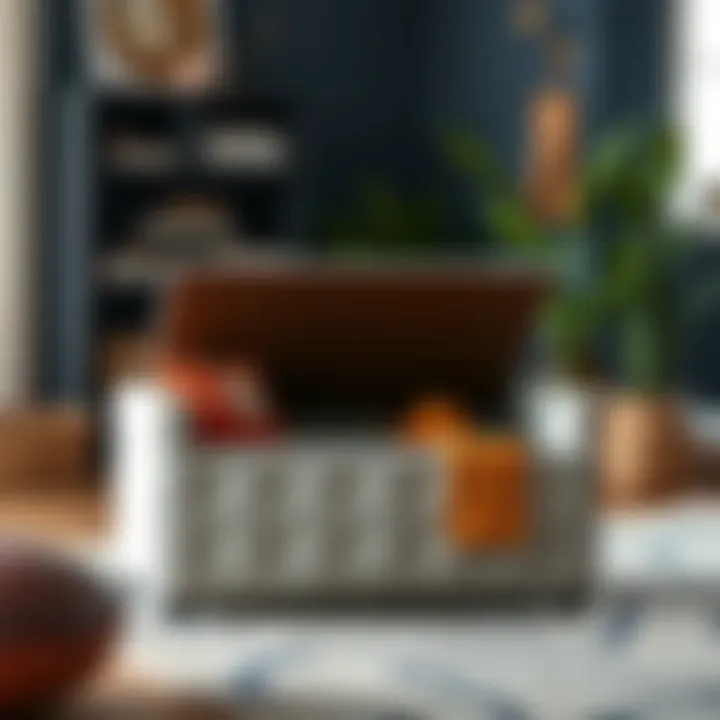
- They contribute to a healthier home environment.
- Reduced carbon footprint by minimizing waste.
- Often hypoallergenic, making them ideal for spaces where children play.
Moreover, eco-conscious designs often incorporate non-toxic dyes and finishes, ensuring safety in homes with children. The trend is more than just a marketing move; it's an ethical choice, tapping into a growing demographic that values responsibility just as much as style. Purchasing a toy box crafted from sustainable materials isn’t just a purchase, it’s an investment in a sustainable future.
Minimalist and Contemporary Styles
The minimalist and contemporary approach to design emphasizes functionality without compromising style. Upholstered toy boxes that align with these aesthetics often exhibit clean lines, subdued colors, and thoughtful shapes. Minimalism isn’t about deprivation; it’s about intentional living. Here are some key elements that define this trend:
- Focus on Functionality:
- Color Palettes:
- These toy boxes often double as decorative pieces and multifunctional seating.
- They are designed to fit seamlessly into various living spaces, from nurseries to modern living rooms.
- Neutral tones prevail, allowing the toy box to complement a wide array of decor styles.
- Occasional pops of color might be seen, particularly in settings that embrace accent tones or playful style.
In these contemporary designs, the emphasis is shifting towards keeping clutter at bay while still ensuring that any piece—be it a toy box or a storage ottoman—looks elegant. This trend echoes a lifestyle choice that favors simplicity and ease, an appealing concept for modern homeowners who seek to create serene, organized living spaces.
"In the realm of interior design, less can sometimes mean more, especially when it comes to children’s spaces where functionality meets style."
With the increasing popularity of upholstered toy boxes that boast sustainable materials and minimalist designs, the options available are vast and varied, making it easy to find a piece that resonates with your unique style and values. By embracing these current trends, anyone can enhance their home’s aesthetic while fulfilling their organizational needs.
Integrating Upholstered Toy Boxes into Home Design
Integrating upholstered toy boxes into home design is not merely a matter of placing an object in a corner; it’s about setting a stage where functionality gracefully meets aesthetics. Each toy box can serve more than just a storage solution—they can reflect personal style, enhance room decor, and even contribute to the overall theme of a space. It’s crucial for homeowners and designers alike to consider both the practical benefits and the visual appeal when incorporating these furniture pieces into their homes.
Choosing the Right Location
When it comes to selecting the perfect spot for an upholstered toy box, location is key. Think about where the action happens in the home. Areas such as playrooms, nurseries, or even living rooms are optimal choices. The box should be accessible to children and practical for parents — not hidden away in a closet.
- Playrooms: Placing the toy box in a designated play area not only makes it convenient for kids to clean up, but it also creates a focal point within the room.
- Living Rooms: An upholstered toy box can double as a chic coffee table or extra seating, blending seamlessly into adult spaces while still serving its purpose.
- Bedrooms: A toy box in the corner can anchor a child’s personal space, adding character without consuming too much real estate.
Consider natural light sources when choosing the location. A well-lit area will not only enhance the visibility of the toy box but also its aesthetics, making the design pop more effectively.
Pairing with Other Furniture Pieces
Finding harmony in a room often involves careful coordination between pieces. Upholstered toy boxes can mesh well with various types of furniture, enhancing their surroundings.
- Sofas and Chairs: If the color or fabric of the toy box complements nearby seating, the entire room achieves a cohesive look. For example, a pastel-colored toy box next to a coordinating armchair can create a soothing atmosphere for playtime.
- Rugs: A well-chosen rug can ground the space, allowing the toy box to stand out as a decorative element. This is particularly effective in larger rooms.
- Shelving Units: When placed near bookshelves, a toy box can encourage tidy habits, demonstrating to children that their toys belong with their books.
Ultimately, it’s about creating a functional yet stylish environment where every piece, including the toy box, plays its part in a harmonious home orchestration. Selecting the right location and pairing the toy box with complementary pieces is essential in achieving an inviting and organized living space.
"In the orchestra of home design, every piece must play its note to create a symphony of function and style."
Integrating upholstered toy boxes into home design elevates them from mere storage solutions to integral components of stylish, functional living spaces.
End: The Value of Upholstered Toy Boxes
Upholstered toy boxes are not merely functional storage units; they are elegant additions to any home decor that seamlessly balance aesthetics and practicality. As we close our exploration, it is crucial to appreciate the multifaceted role these pieces play in enhancing both the functionality and style of a room. In today’s environments where living spaces are often compact, having solutions that also serve as decorative elements is highly valuable.
One significant advantage of upholstered toy boxes is their ability to help organize clutter while adding a touch of personality to the child’s room or play area. They come in various shapes, sizes, and styles, making it easy to find the perfect piece that resonates with the overall theme of the interior design. A well-chosen toy box does not just blend in; it stands out as an integral component of the decor.
Moreover, the wide array of fabric and color choices allows homeowners and designers to infuse creativity into the design. Whether opting for bold patterns that ignite a sense of joy or calming soft tones that promote tranquility, the toy box can set the tone for the entire room. As we focus on function, it’s important to note how these storage units double as seating options, efficiently utilizing space in small homes.
In summary, the elegance and functionality of upholstered toy boxes extend beyond mere storage. They are at the intersection of design and practicality, offering solutions to storage challenges while contributing significantly to a child’s environment. The lasting appeal of these pieces lies in their ability to adapt to evolving design trends and household needs, ensuring they remain relevant in contemporary settings.
Summary of Key Points
- Upholstered toy boxes combine design elegance with functionality, serving both as storage and decorative elements in home settings.
- They come in various styles, sizes, and colors, allowing for personalization and uniqueness to match different interiors.
- The dual-purpose nature of these items enhances their utility, especially in smaller living spaces.
- Choices in fabric and detailing not only impact the aesthetic but also cater to diverse needs for comfort and style.
Final Thoughts on Design and Functionality
As we reflect on the significance of upholstered toy boxes, it's clear that they embody a thoughtful design ethos. They represent a shift towards practical yet beautiful home furnishings, accommodating the needs of modern families while maintaining a stylish appeal. Selecting the right upholstered toy box involves considering not just the practical aspects like durability and size but also the ambiance and character it brings.
In a world where minimalism and smart design are gaining traction, these toy boxes stand out as valuable pieces for any homeowner or designer. Their adaptability to different styles and the emphasis on quality craftsmanship conversation, remind us that functionality does not need to come at the expense of elegance.
"When function meets style, you create a space that not only serves your needs but also tells your story."
For further reading on the evolution and various styles of upholstered furniture, check resources like Wikipedia or Britannica.
When investing in furniture for children’s spaces, sites like reddit.com may offer valuable recommendations and discussions surrounding practical design choices.



